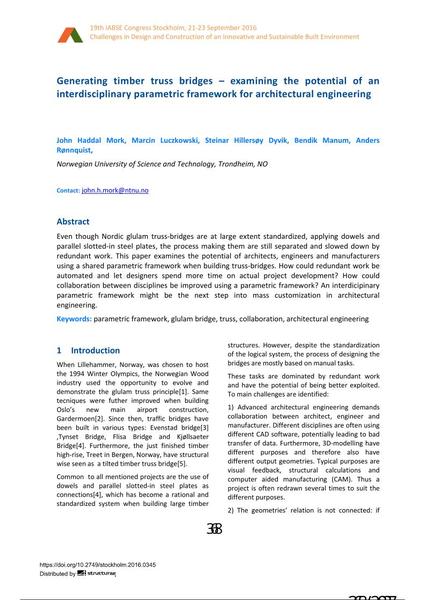Generating timber truss bridges – examining the potential of an interdisciplinary parametric framework for architectural engineering

|
|
|||||||||||
Bibliografische Angaben
| Autor(en): |
John Haddal Mork
(Norwegian University of Science and Technology, Trondheim, NO)
Marcin Luczkowski (Norwegian University of Science and Technology, Trondheim, NO) Steinar Hillersøy Dyvik (Norwegian University of Science and Technology, Trondheim, NO) Bendik Manum (Norwegian University of Science and Technology, Trondheim, NO) Anders Rønnquist (Norwegian University of Science and Technology, Trondheim, NO) |
||||
|---|---|---|---|---|---|
| Medium: | Tagungsbeitrag | ||||
| Sprache(n): | Englisch | ||||
| Tagung: | IABSE Congress: Challenges in Design and Construction of an Innovative and Sustainable Built Environment, Stockholm, Sweden, 21-23 September 2016 | ||||
| Veröffentlicht in: | IABSE Congress Stockholm, 2016 | ||||
|
|||||
| Seite(n): | 368-376 | ||||
| Anzahl der Seiten (im PDF): | 9 | ||||
| Jahr: | 2016 | ||||
| DOI: | 10.2749/stockholm.2016.0345 | ||||
| Abstrakt: |
Even though Nordic glulam truss-bridges are at large extent standardized, applying dowels and parallel slotted-in steel plates, the process making them are still separated and slowed down by redundant work. This paper examines the potential of architects, engineers and manufacturers using a shared parametric framework when building truss-bridges. How could redundant work be automated and let designers spend more time on actual project development? How could collaboration between disciplines be improved using a parametric framework? An interdicipinary parametric framework might be the next step into mass customization in architectural engineering. |
||||
| Stichwörter: |
Fachwerkbinder
|
||||


